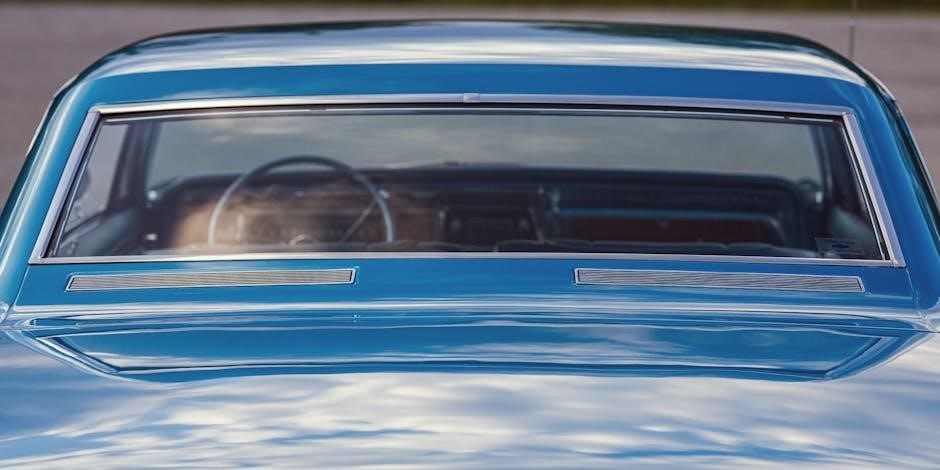
chevy silverado manual 4 wheel drive wont engage
Chevy Silverado Manual 4 Wheel Drive Won’t Engage: Troubleshooting Guide
Experiencing 4WD engagement issues with your Chevy Silverado? This guide offers a systematic approach․ We will break down common problems and diagnostic steps․ It will help you pinpoint the source of trouble․ This is applicable to manual 4WD systems․ We will provide solutions for getting back on track․

Understanding Your Silverado’s 4WD System
The Chevy Silverado’s 4WD system provides enhanced traction․ It is crucial for off-road conditions․ The manual system uses a floor-mounted lever for direct mechanical engagement․ This system shifts between 2WD and 4WD modes․ The 4WD system includes the transfer case․ It also includes the front axle and related components․ The transfer case directs power to both the rear and front axles․

Understanding the 4WD modes is essential․ 4Hi is for on or off-road driving with light conditions․ 4Lo provides increased torque for challenging terrains․ The system relies on mechanical linkages․ Proper function depends on their smooth operation․ Familiarizing yourself with these components is important․ This will make the diagnostic process easier․ This will help you troubleshoot any 4WD issues effectively․
Regular maintenance and understanding the system will help․ This will ensure reliable performance․ This helps prevent problems․ When issues arise, knowing the basics will help․ It will guide you through the troubleshooting steps efficiently․ We will help you keep your Silverado performing at its best․
Common Causes of 4WD Engagement Failure
Several factors can cause a Chevy Silverado’s manual 4WD to fail․ A common culprit is a malfunctioning transfer case․ This issue may involve internal damage or wear․ Linkage problems between the shift lever and transfer case can also occur․ Corroded or damaged linkages can prevent proper engagement․ Low transfer case fluid levels can hinder the system’s ability to shift effectively․
Another potential cause is a faulty front axle actuator․ This component engages the front axle․ A defective actuator can prevent the front wheels from receiving power․ Issues with the vehicle’s wiring and connections can also lead to problems․ Damaged or corroded wires can disrupt the electrical signals needed․ This disruption can prevent the 4WD system from functioning correctly․
Lastly, internal problems within the transfer case itself can arise․ This can occur due to wear and tear or lack of maintenance․ Identifying these common causes is the first step․ This leads to effective troubleshooting and repair․ Addressing these issues promptly will help restore your Silverado’s 4WD functionality․
Checking the Transfer Case Selector Switch
The transfer case selector switch is crucial for engaging 4WD․ Inspect the switch for any physical damage or looseness․ A damaged switch may not properly signal your desired 4WD mode․ Ensure the switch moves smoothly between positions․ Binding or stiffness could indicate internal problems․
Test the electrical connections to the switch․ Use a multimeter to check for continuity․ Verify that the correct signals are sent․ This is done when you move the switch to different 4WD modes․ A faulty switch might not send the necessary signals․ This will prevent the transfer case from shifting․
Also, inspect the wiring harness connected to the switch․ Look for signs of corrosion or damage․ Clean any corroded terminals․ Repair any damaged wires․ If the switch appears functional but the 4WD still won’t engage, consider replacing it․ A new switch can resolve intermittent electrical issues․ Make sure to use a compatible replacement switch for your Silverado model․ Proper switch function is vital․ It ensures reliable 4WD engagement․
Inspecting the Transfer Case and its Components
The transfer case is the heart of your Silverado’s 4WD system․ Begin by visually inspecting the transfer case for external damage․ Check for cracks, leaks, or signs of impact․ Any damage could indicate internal component failure․
Next, examine the transfer case linkage․ Make sure it connects to the shift lever․ Ensure it moves freely․ Binding or loose linkage can prevent proper engagement․ Inspect the shift motor․ This is applicable if your model has one․ Listen for unusual noises when shifting into 4WD․ Grinding, clicking, or whining sounds suggest internal wear or damage․
Check the condition of the transfer case fluid․ Low or contaminated fluid can hinder performance; Drain a small amount and examine its color․ Look for metal shavings or debris․ These are indicators of internal damage․ If the fluid appears dirty, replace it with the recommended type․ After fluid replacement, test the 4WD system․ See if there is any improvement․
Diagnosing the Transfer Case Control Module (TCCM)
The Transfer Case Control Module (TCCM) manages the 4WD system․ It interprets driver input․ It then controls the transfer case motor․ If your Silverado has electronic shift controls, the TCCM is critical․
Begin by checking the TCCM for any visible damage․ Look for corrosion or loose connections․ Inspect the wiring harness connected to the TCCM․ Ensure the wires are secure and undamaged․ Use a multimeter to test the power and ground connections․ Verify that the TCCM is receiving the correct voltage․
Next, use a diagnostic scan tool․ Check for any trouble codes related to the TCCM․ Common codes might indicate communication errors․ They might also indicate issues with the shift motor circuit․ If codes are present, research their meaning․ Then follow the diagnostic procedures․ This is specific to your Silverado model․ If the TCCM is faulty, replacement may be necessary․ After replacement, reprogram the new module․ This will ensure compatibility with your vehicle․
Examining the Front Axle and Actuator
The front axle and actuator are essential for 4WD engagement․ They connect the front wheels to the drivetrain․ This allows them to receive power․
Start by visually inspecting the front axle․ Look for any signs of damage․ Common signs are leaks, cracks, or worn components․ Check the axle shafts․ Make sure they are not bent or broken․ Then examine the differential․ Ensure it is properly sealed and free from leaks․
Next, inspect the front axle actuator; This component engages the front axle․ This allows it to receive power from the transfer case․ Check the actuator wiring․ Verify that the connections are secure and free from corrosion․ Use a multimeter to test the actuator’s electrical function․ Activate the 4WD system․ Listen for the actuator to engage․ If the actuator is not functioning, replace it․ Test the 4WD system after replacement․ This ensures proper engagement․

Checking Fluid Levels and Condition
Proper fluid levels and condition are vital for the 4WD system․ This includes the transfer case and differentials․ Start by checking the transfer case fluid․ Locate the fill plug on the transfer case․ Remove the plug and check the fluid level․ The fluid should be level with the bottom of the fill plug hole․
Inspect the fluid’s condition․ Look for signs of contamination․ These signs are discoloration, a burnt odor, or metal shavings․ If the fluid is contaminated, drain and replace it with the recommended type․ Refer to your Silverado’s owner’s manual for specifications․ Next, check the front and rear differential fluids․ Locate the fill plugs on each differential․ Remove the plugs and check the fluid levels․ The fluid should be level with the bottom of the fill plug hole․
Inspect the differential fluids․ Look for contamination․ If the fluid is contaminated, drain and replace it․ Maintaining proper fluid levels and condition ensures optimal 4WD system performance․
Inspecting Wiring and Connections
A thorough inspection of the wiring and connections is essential․ This is crucial for diagnosing 4WD engagement issues․ Begin by visually examining all wiring harnesses․ Pay close attention to those related to the transfer case, front axle actuator, and TCCM․ Look for signs of damage, such as frayed wires, cracked insulation, or corrosion․

Check all electrical connectors․ This includes those at the transfer case selector switch․ Also, check the transfer case control module, and front axle actuator․ Ensure that the connectors are securely attached․ Look for corrosion or damage․ Clean any corroded terminals with electrical contact cleaner․ Apply dielectric grease to protect against future corrosion․ Use a multimeter to test the continuity of the wiring․ Compare your results to the wiring diagrams․ It will help you identify any breaks or shorts․ Check the ground connections for the 4WD system components․ Ensure they are clean and tightly secured to the chassis․ Poor ground connections can cause intermittent electrical problems․
Maintenance Tips for Preventing 4WD Problems
Preventative maintenance is crucial for ensuring the longevity and reliability of your Silverado’s 4WD system․ Regularly inspect the transfer case, differentials, and other 4WD components for any signs of wear or damage․ Change the transfer case fluid and differential fluids according to the recommended service intervals in your owner’s manual․
Ensure the tire sizes and pressure are properly maintained․ This can affect the performance of the 4WD system․ Periodically engage the 4WD system, even if you don’t frequently need it․ It will help keep the internal components lubricated and prevent them from seizing․ When engaging 4WD, do so on surfaces where there is some give, such as gravel or dirt․ Avoid engaging 4WD on dry pavement, as this can cause undue stress on the drivetrain․
Consider having your 4WD system serviced by a professional mechanic every 12 months․ Proper maintenance will help keep your Silverado’s 4WD system functioning optimally․
Using Diagnostic Tools for Service 4WD Issues
When troubleshooting 4WD issues in your Chevy Silverado, diagnostic tools can provide valuable insights․ A scan tool that connects with your Silverado’s computer can retrieve diagnostic trouble codes (DTCs) stored in the transfer case control module (TCCM)․ These codes can pinpoint the specific area of the 4WD system that is experiencing a problem․ More advanced scan tools can perform live data readings, allowing you to monitor the performance of various sensors and actuators in real-time․
A multimeter is helpful for testing the electrical circuits related to the 4WD system․ You can test the continuity of wires, check for voltage at the transfer case selector switch, and verify the operation of the front axle actuator․ A specialized tool for measuring driveline vibrations can help diagnose worn or damaged driveline components such as universal joints or center support bearings․ These tools can provide valuable information for diagnosing and repairing 4WD issues, helping you get your Silverado back in top shape․

